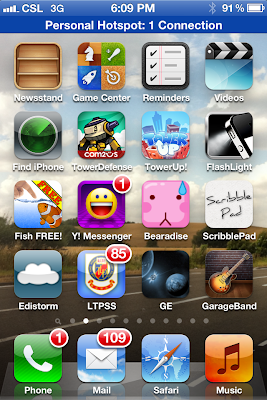There's more to mobile technologies than just having a device to access email and Facebook at school.
How students and teachers utilise such technologies for teaching and learning is something to look into. As a teacher that uses mobile products, I can share from my experience.
Here are some of the ways they can be used:
As a photo/video capture device and multimedia tool
Thanks to the advancements of camera quality in recent smartphones, such devices can double-up as pretty good cameras for taking both photos and videos. The media can then be uploaded to a school website, teaching blog or wiki for students to learn from.
Clips can also be edited with software to create tutorials, announcements, podcasts and other informative videos.
Below is a sample of a video I shot using just an iPhone 4
(which will later be used for our Campus TV):
As a centralised paper-reducer solution
Almost any teacher will agree that they don't like carrying lots of paper and heavy books around. Why not try consolidating your notes and learning materials onto an iPad 2? That's exactly what I do, and it's hard for me to look back.
What you need is a mobile device (iPad 2), a centralised 'cloud' storage solution, a variety of apps and an INTERNET connection.
With regards to 'cloud' storage solutions and apps, I use 'Evernote' (
www.evernote.com) to make notes on the iPad for reference purposes. I use 'Dropbox' (
www.dropbox.com) to upload and download my work materials. Knowing that my notes and files are in one centralised location, I need not worry about certain files being in different, hard-to-find locations (e.g. different computers on campus, or even at home).
Naturally, a cloud solution can only be effective with an Internet connection, so you must ensure your devices have WiFi or 3G.
As a convenient research tool brought to students
Students can now use iPad 2 devices (and a WiFi connection around campus) to work remotely in various areas around school wherever they feel comfortable - including their own classroom. Students won't have to bring themselves to the technology (students walking to IT labs to use computers) - the technology will be brought to them (iPads delivered to a classroom to be used by students).
This results in students having access to their subject materials (regular subject books) and an Internet communicator on their own desk at the same time.
As an example, on the left side of the desk they could have an iPad for researching Internet materials (via. Safari). On the right side of the desk they could have their regular exercise books, textbooks and other subject-specific resources.
Very convenient!
As a collaboration tool
Mobile devices can be used by students to collaborate on projects and various subject-specific tasks.
You could have lots of students connecting to a Google Doc (docs.google.com) to work on a project, or students working concurrently on Evernote Premium (www.evernote.com/about/premium) to gather notes and ideas into one convenient location.
Mobile devices can be used by students to collaborate on projects and various subject-specific tasks.
You could have lots of students connecting to a Google Doc (docs.google.com) to work on a project, or students working concurrently on Evernote Premium (www.evernote.com/about/premium) to gather notes and ideas into one convenient location.
THIS JUST IN:
Law Ting Pong Secondary School (LTPSS) has an App! :)


My school recently released an iOS App called 'LTPSS'. It works as a handy portal for staff, students and guests to learn about our school and find information on what our school provides etc. It's also acts as a portal for the school intranet.















